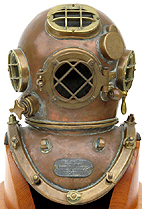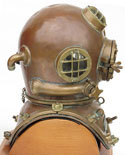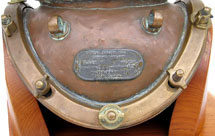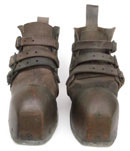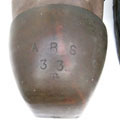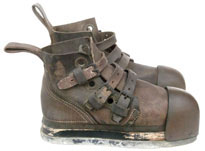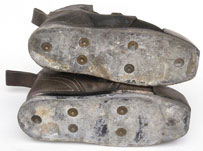DIVING & SUBMARINES
Catalog Page 10
When no price is shown, use
Click on photos for larger images.
|
10.18 SUBMARINE PIN and PATCH COLLECTION. Very nice assemblage of 8 World War II vintage U.S. Navy submarine pins and sleeve badges. There are three embroidered enlisted sleeve badges, three uniform pins, one sweetheart pin and one tie clip. All are of highest quality and of American manufacture. Many are signed with their maker’s name. The tie tack is unused, presented on its original mounting card with celluloid cover and is signed “BASTIAN PRCS CO. ROCHESTER, NY.” Mint! 295 for all |
|
PINS
|
PIN BACKS
|
TIE CLASP
|
|
10.17 HARD HAT DIVING BOOK. Sir Robert Davis, “Deep Diving and Submarine Operations, A Manual for Deep Sea Divers and Compressed Air Workers,” 6th Edition, 1955, The Saint Catherine Press Ltd., London. Hard cloth cover, 690 pages exclusive of index and inclusive of Appendices A though G. Without question the most comprehensive book ever published concerning underwater operations from a uniquely British perspective, but containing much information derived from foreign navies’ undersea operations. It contains two sections. Part I is “A Summary of the Present State of the Art of Deep Diving.” Part II is entitled “The Secrets of The Deep” dealing with treasure, salvage and “A Short History of Diving, Diving Appliances and early Submarine Vessels.” The frontispiece contains an amazing fold-out page measuring over 23 inches wide entitled “ A Diagrammatic Impression of Underwater Activities.” 7 ¼ by 10 inches. Good condition showing actual use and minor wear. A BIG book with BIG content! Very scarce! 179 |
|
PLATE 1
|
PLATE 2
|
PLATE 3
|
|
10.16 VINTAGE HARD HAT DIVING CATALOG. Extremely scarce, original bound catalog from the venerable Morse Diving Equipment Company of Boston. This centenary edition of the company’s founding in 1837 is decorated with a rendering of an early commercial diving helmet and reads, “DIVING APPARATUS / ESTABLISHED 1837 / ANDREW J. MORSE & SON, INC. BOSTON, MASS. U.S.A.” The catalog with heavy card cover and spiral binding, contains remarkable drawings complimented by detailed descriptions and (to die for) prices of hard hat diving equipment manufactured by this enduring company during the Depression years of the United States. This was at the time when a Mark V helmet could be had for $225! 49 pages, one of which contains detailed decompression tables. Also included is an original old black and white photograph of a diver in U.S. Navy Mark V diver dress. Excellent original condition, noting old fountain pen stains to a number of pages on the lower right margins which in no way affects the content. 8 ½ by 10 ½ inches. Now the catalog is worth more than the original cost of a helmet! Circa 1937. 349 The exact photograph offered here is shown in the book "On The Bottom" by Commander Edward Ellsberg, poublished in 1929. The plate on page 181 is captioned,"Chief Torpedoman Kelley with the Ellsberg torch." |
|
CATALOG & PHOTO
|
PLATE 1
|
PLATE 2
|
|
10.15 DIVING EQUIPMENT
CATALOG. Scarce, original bound catalog from
the venerable Morse Diving Equipment Company of
Boston. The heavy card stock cover features an image
of a 3 light commercial helmet and reads, “DIVING
EQUIPMENT / ESTABLISHED 1837 / MORSE DIVING EQUIPMENT CO.,
Inc. BOSTON, MASS. U.S.A.” The back of the title
page reads “1837-1971.” This soft cover
catalog contains 24 pages of crisp original photographs and
remarkable drawings with descriptions detailing this
enduring company’s output of old school hard hat
diving equipment of all types. 8 ½ by 11
inches. Outstanding original, near mint condition,
noting the penned name and phone number of the shop foreman,
Frank Caruso, in 1971.
249 |
|
PLATE
|
PLATE 2
|
|
10.14 HARD HAT DIVER’s
WEIGHTS. Very scarce, original, matched pair
of front and back lead weights for the iconic Miller Dunn
style III shallow water diving helmet, otherwise known as
the “DIVENHOOD.” These authentic lead
weights mounted to the front and back of the helmet’s
breastplate. They are complete with their original
brass wing nuts mounted on stove bolts. The weights
are impressed “FRONT – WT. NO.3 DIVINHOOD
MILLER-DUNN CO. MIAMI. FLA.” and “BACK –
WT. NO.3 DIVINHOOD MILLER-DUNN CO. MIAMI, FLA.” They
weigh 8 and 16 pounds respectively. The holes for the
front weights measure 3 ¼ inches on center and those
for the back weights measure 4 inches. Each is
impressed with the serial number “886.”
Excellent old original condition showing good care and
actual use. |
|
10.11 SOVIET SUBMARINES PHOTO. Original mid-1900’s or earlier photograph of a Soviet submarine tender at berth alongside a pier with 7 diesel submarines nested on its outboard side. This original black and white photo shows in good detail shipping and dockside activity, including 3 ship’s boats on deck and one in the water next to the starboard bow. 3 ¼ by 5 inches. This photo exhibits a “serrated” edge popular in such post card size photos from the 1930’s into the 1950’s. Excellent condition. Rare subject matter. 10 |
|
10.08 DIVER’s BOOTS.
Genuine pair of mid-century American hard hat diver’s
boots. This matched set of hefty hard hat diver’s
shoes has thick canvas uppers attached to wooden soles with
heavy bronze treads. Each has thick leather
straps with brass buckles and heels trimmed in
leather. The toes are of solid brass as are the
grommets holding the cotton rope laces. Each boot
measures 14 inches long by 4 3/4 inches wide by 12 inches
high and weigh 22 pounds total. Absolutely perfect
original condition showing very little use. As
such these massive boots make for an awesome
display. |
|
10.70 SUBMARINE BINOCULARS. Very
rare World War II vintage U.S. Navy submarine conning tower
binoculars known as “Torpedo Forward Control
Binoculars.” This extremely heavy optical device bears
the brass maker's tag reading "U.S. NAVY - BU. OF ORD.
TELESCOPE MARK 91 MOD. 1 WT. 40 SER. NO. 1687 BAUSCH &
LOMB OPTICAL CO." To combat the effects of sea water, the
body of these binoculars was made of solid stainless steel
-- a very, very scarce commodity during the war and its use
is indicative of the importance placed upon them! These
gas-filled binoculars consist of two heavy cylinders each
measuring 4 inches in diameter. Each is connected to a thick
common rod with two stout mounting plates having four points
of support.. The rod allows the binoculars to pivot
independently of each other to adjust for interpupilary
distance; the angle of which is indicated on a scale above.
The distance is adjusted by a retractable lever on the
objective end. Each objective is fitted with a spring-loaded
lens cover which snaps open and shut. In addition, built
into each cover is yet another spring-loaded filter for
daylight viewing in haze or bright sunlight. The field
produced by the large objective lenses and internal prisms
is wide, clear and highly magnified. Prominent cross hairs,
much like the submarine's periscope, are visible in the
field. To the viewer's right is a lamp housing for
illumination of the cross hairs at night. A prominent toggle
switch operates the lamp. The oculars are protected by their
original rubber eye cups which are in exceptionally fine
original condition. This remarkable unit comes complete with
its original machine-dovetailed wooden storage box. The
stout box has a hinged lid with retainer chain, snap
closures, and substantial bail carrying handles on either
side. It measures 14 1/2 inches long by 14 inches wide and 9
1/2 inches high. The binoculars measure 11 inches long by 10
1/2 inches wide at the widest and 5 1/2 inches thick. The
entire assembly weighs 53 pounds. The box is in excellent
original condition with minimal surface wear only. The
binoculars themselves are virtually perfect -- as last used
in World War II! Bausch and Lomb company was founded in 1853 by Germans
John Jacob Bausch and Henry Lomb in Rochester, New York,
specializing in optical devices and surgical instruments. At
the outbreak of the Civil War, Lomb enlisted and rose to the
rank of captain. He returned to Rochester in 1863 and the
following year the firm became "Bausch and Lomb, Optician."
After the Civil War, interest in spectacles rose rapidly.
The company enlarged its factory in 1868 and changed its
name to the "Vulcanite Optical Instrument Company,"
reflecting the popular use of vulcanized rubber in making
spectacle frames. The name changed back to the "Bausch and
Lomb Optical Company" in 1876. After World War II it
became "Bausch and Lomb, Inc." |
|
BOX
|
INBOX
|
TOP
|
BOTTOM
|
|
10.94 MARK V DIVING HELMET. This is it!
The ultimate! Offered here is the very sought after, and by
far most collected hard hat diving helmet ever -- an
authentic World War II era U.S. Navy Mark V. But even more
special, this is a scarce example by the Miller Dunn Company
of Miami, in its original tin finish! The front of this
handsome helmet bears the embossed lead breastplate maker's
tag reading:
This helmet is made of heavy spun
copper with cast brass fittings and thick glass ports. The
interior is tinned and the bonnet has air channels leading
from the air intake goose neck over the three ports. The
phone communicator gooseneck contains its original
components with cap and the fittings for holding the
transducer are present. The chin button is in place and
functions properly. On the exterior, all fittings are
original and in tact. Each of the four brales bear serial
numbers matching that of the breastplate tag. The entire
unit, weighing 50 pounds, is in excellent
totally original condition! There
are of course the expected minor dents and dings in the top
of the bonnet from actual diving! * For the privacy and security of the ultimate
purchaser, the serial number of this helmet is being
withheld. |
|
10.95 EARLY HARD HAT DIVER’s
BOOTS. Very scarce, early 1900’s
diver’s boot with leather uppers and brass
fittings. This original old matched pair has bronze
toes with wooden insoles and lead bottoms. The leather
ia in a remarkable state of original preservation. Of
great significance is the fact that the right boot is marked
on the bronze toe “ARS 33.” It is also
stamped “R” designating the right boot. In
total this set weighs more that 40 pounds! In
Leon Lyons’ground breaking work, “Helmets of the
Deep,” 1988, Leon Lyons, Hollywood, Florida, an
identical pair of boots are depicted on page 330 described
as “2. American – A. Schraders Son.”
USS CLAMP (ARS-33) was a Diver class rescue and salvage ship acquired by the U.S. Navy soon after America entered World War II. CLAMP was launched October 24, 1942 by the Basalt Rock Co., Napa, California, under a U.S. Maritime Commission contract and was commissioned as a U.S. Navy vessel on August 23, 1943.
Charged with the task of aiding stricken vessels,
CLAMP sailed from San Pedro on September 30,
1943. After a brief period at Pearl Harbor,
CLAMP arrived in the Ellice Islands on November
8th. From this base she conducted combat salvage operations
supporting the invasion of the Gilbert Islands. |
||||||||||||||||||||||||||||||||||||
10.89 HARD HAT DIVING PUMP. Genuine first half of the 1900’s American shallow water diving pump made by the “MILLER-DUNN CO. MIAMI FLA.” as cast in relief on the cylinder heads. This model “NO. 1A” consists of twin vertical brass cylinders connected to a pivoted rocking beam. The beam and cylinders are connected to the cast iron bedplate which was attached to a wooden mounting board during actual use. The cylinders pivot on their mounts, as does the rocker arm. Pistons with leather seals within the twin cylinders pumped air to the diver by means of a rubber hose connected in series to the sides of the cylinders. Stressing simplicity in their design, Miller Dunn made the coupling to fit a common garden hose! The brass coupling and hard rubber gasket are both still present on this example. In the top of the rocking beam a slot is provided for the insertion of a long metal handle. It was held with a set screw which is still present. This pump was designed to provide air to a diver wearing one of Miller-Dunn’s three famous “shallow water” helmets. A shallow depth was considered to be one atmosphere of pressure or approximately 30 feet. As configured this pump stands 14 ½ inches tall, 12 ½ inches long, 5 ½ inches wide and weigh 28 pounds. It is in excellent “as last used” condition, still retaining its original haze gray paint and still pumping air! 795
The now legendary Miller-Dunn Company of Miami is shrouded in a good deal of mystery, even though it is documented that the company produced hard hat diving helmets over the course of more than 30 years. Begun in 1915 as a partnership between a plumber and machinist the company was best known for its shallow water "Divinhood" designs which were patented in the United States and abroad. In his monumental reference book "Helmets of the Deep" by Leon Lyons, 1988, Leon Lyons, Hollywood, Florida, Mr. Lyons writes on page 133, "The number two and 3 styles are most popular among collectors of nautical antiques. They have such a strange look about them.”
10.85 HARD HAT DIVING PUMP. Authentic
first half of the 1900's American diving pump made by "MORSE DIVING
EQUIPMENT CO., INC. BOSTON, MASS. U.S.A." as cast in relief on the
body of the pump. On the reverse side is cast the model number "No.
15." This twin cylinder shallow water pump is made of solid bronze
mounted to an oak platform. The one-man reciprocating pump is
operated by a steel handle with a perpendicular oak grip. As
configured it measures 31 1/2 inches long on the oak base and stands
approximately 46 1/4 inches high. The pump itself measures 20 1/2
inches long by 8 inches wide on the base. The entire unit weighs 54
pounds! Matching serial numbers on the pump and rocker arm. The
genuine quality handle is a faithful replacement. ![]()
![]()
In the catalog of Andrew J. Morse & Son, Inc. Edition 5M, copyrighted in 1937, page 15 through 17 are devoted to this pump and the shallow water diving helmet associated with it. It is described as, "The No. 15 Pump has two cylinders which are single action, and as shown by the illustration, are made in one bronze casting. The discharge valves and the hose outlet are connected by brass pipe, so arranged that the cylinder heads may be easily removed. The results of tests made show that our Shallow Water Outfit is entirely satisfactory provided the depth of the water does not exceed 36 feet." The price of the pump in 1937 exclusive of additional equipment or fittings was listed at $100.
|
|
|
|
|
|
|
|
|
|
|
|
|
|
10.80 EARLY SUBMARINE PHOTOGRAPH. Very scarce, pre-World War II black and white photograph entitled "Officers & Crew of U.S. Submarine Pike" lower center and dated "Dec 11, 1937" lower right. This very crisp image shows no less than 49 officers and men of this famous submarine posed on the main deck and abaft the conning tower. Each crewman wears the old style Navy flat hat with the name "USS PIKE" on the hat band. This "Old Navy" submarine still bears the bold, outdated designation "P2" on the side of the conning tower with running lights just forward and portholes on the navigation bridge! Aficionados of early submarines will be particularly interested to note the sub's superstructure and periscope are clearly visible as are its searchlight and anchor lamp on the conning tower. This photo was taken before the invention of the snorkel. The image measures 7 3/4 by 9 1/2 inches and is housed under glass in its original simple wooden frame with stiff red board backing measuring 9 by 10 3/4 inches. Outstanding original condition. 195
USS PIKE (SS-73) was laid down on December 20, 1933 by the Portsmouth naval Yard in Kittery, Maine and launched on September 12, 1935. She was commissioned on December 2, 1935. PIKE was the first all-welded submarine. Her welded hull allowed PIKE to submerge to much greater depths than previous submarines, while providing greater protection against depth-charge attacks. She had a length of 283 feet, a beam of 25 feet and displaced 1,934 tons.
After shakedown in the Atlantic, PIKE departed Newport, Rhode Island for San Diego. During 1937 and 1938, she participated in maneuvers near Hawaii. During 1940 and 41 she served with Sub Squadron 5 along the China Coast from Shanghai to Tsingtao.
In response to the Japanese attack on Pearl Harbor she put to sea on December 8, 1941 to guard sea lanes between Manila, Hong Kong and Australia into early 1942.
On her fourth war patrol from Fremantle, Australia she sailed north of the Palau Islands and Wake Island, before reaching Pearl Harbor in late May. After an overhaul at the Mare Island Naval Shipyard, California, she was again in service in December guiding bombers to Wake Island. During an attempted attack off the coast of Japan on January 14, 1943 she escaped a severe depth-charge counterattack. In April she fired torpedoes at targets off Truk, and shelled Satawan Island.
On August 5, 1943 PIKE sank the 2,022-ton Japanese cargo ship SHOJU MARU near Marcus Island. After that success, she departed Pearl Harbor arriving at New London, Connecticut on November 3, 1943. She remained there for the duration of the war as a training vessel at the Submarine Base.
USS PIKE was decommissioned at Boston on November 15, 1945 and became a Naval Reserve training ship at Baltimore in September 1946. Upon completion of those duties, she was stricken from the Naval Register on February 17, 1956 and sold for scrap.
PIKE received four battle stars World War II service.
|
|
|
|
|
|
DETAIL |
|
|
|
10.76 SUBMARINE CLOCK. Genuine deck clock from a Cold War era Soviet nuclear submarine! This fine quality, precision timepiece has a white enameled dial with Arabic numerals, simple black steel hands, minute chapter and large seconds sweep. The 12 o'clock position is marked by the distinctive Red Star and the 6 o'clock position is marked by the classic Naval symbol, a fouled anchor. The dial is decorated with the image of a nuclear submarine conning tower and dive planes and the word (translated) "Komandirskie." This indicates the clock was made for officers (kommanders), and was a prominent fixture in the Officers' Quarters. The bottom of the clock is signed in Cyrillic, "Made in U.S.S.R." The high grade movement was built in typical Soviet style -- like a truck! The heavy stainless steel plates house a large brass spring-barrel with a classic overwind protection feature known as a "Geneva stop" and a jeweled lever escapement. A Fast/Slow lever is present at the 12 o'clock position, concealed when the bezel is closed. The hinged bezel is nickel-plated brass affixed with 6 screws and when closed it seats on a rubber gasket with an airtight fit. The contoured clock case is cast aluminum with the bezel opening on the right. It incorporates a clever locking device which is operated by the winding key. The back of this clock is complete with it original bulkhead mounting plate which allows it to be easily removed using the spring-loaded tab seen at the top. The mounting plate is 9 inches in diameter. The clock itself is 8 1/4 inches in diameter and 3 inches deep. Outstanding original condition showing actual use but no abuse. An excellent timekeeper. Complete with the original winding key! 895
Upon the demise of the former Soviet Union in the 1990's a number of so-called "Russian submarine clocks" came onto the commercial market. Those clocks were newly made to be sold for profit. They were not designed for, nor did they ever see actual use in the Soviet Fleet. This earlier example is an actual Soviet submarine clock that has seen military service, dating from the 1960's.
|
|
|
|
|
|
|
|
|
|
10.21 Authentic U.S Navy hard hat Mark V diving helmets for sale in quantity from salvage.
 |
 |
 |
 |
 |
 |
 |
 |
 |
 |
 |
 |
 |
 |
 |
 |
 |
 |
 |
 |
 |
 |
 |
 |
 |
 |
ANSWERS TO AUTHENTICATION QUIZ
IN "FEATURES" ARTICLE
"The U. S.
Navy
MARK V,
Diving Deep Into Authentication"
The genuine Mark V helmet is on the right.
1. Center and left helmets have been chemically darkened, including all exterior fittings. The copper shells of original Mark V's were coated with tin, but ususally the fittings were not tinned.
2. The faceplate wing nut does not seat "within" the grooved faceplate prong of the center and left helmets, as it does on the genuine Mark V.
3. Brale lug nuts are the same on the center and left helmets. On the genuine Mark V, the lug nuts at the 12, 3, 6, and 9 o'clock positions have an enlarged flange to prevent pinching of the suit at the joints.
4. No mounting plate for sacrificial zinc in between the faceplate and left (diver's) port on the center and left helmets.
5. The genuine Mark V has breastplate eyelets, whereas the center and left helmets have breastplate lugs or nipples.
6. The shape of the genuine Mark V breastplate describes a deep arch. The breastplates of the center and left helmets are squared off and not as deep.
7. The breastplate studs on the reproduction Mark V's are riveted to the breastplate. The eyelets on a real Mark V protrude through the breastplate and are secured from the backside NOT with rivets.
© 1998-2014 West Sea Co. All rights reserved.





























